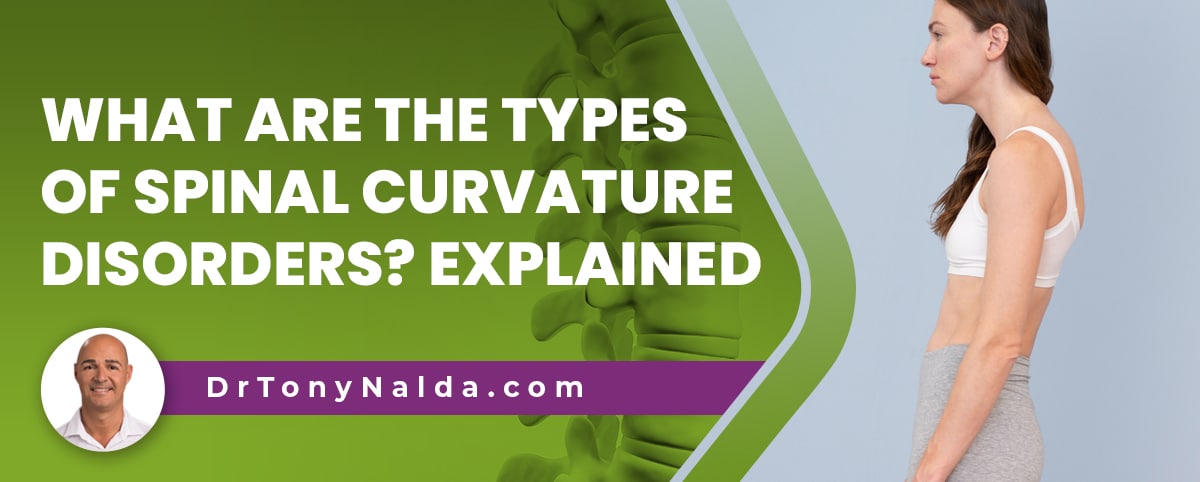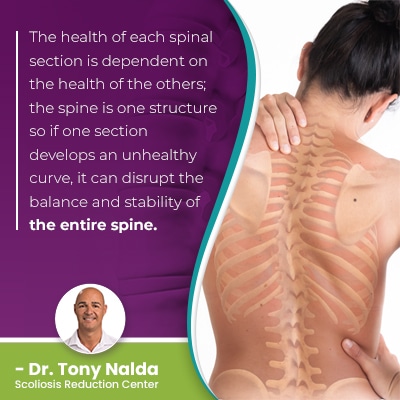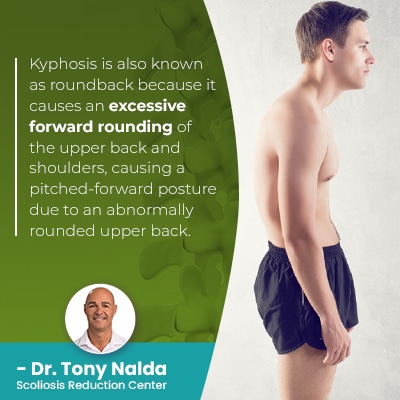What Are the Types of Spinal Curvature Disorders? Explained

The spine's natural curves are key to its health and function; they help the spine stay strong, flexible, and able to absorb and distribute mechanical stress. While the size of spinal curves can vary from person to person, if they don't fall within a healthy size range, the curves can be problematic and considered spinal curve disorders.
There are a number of spinal conditions that involve a loss of the spine's healthy curves and alignment; three common disorders are scoliosis, kyphosis, and lordosis. Let's explore the differences between a sideways spinal curve, an exaggerated outward spinal curve, and an excessive inward curve.
Spinal health is important for quality of life, so let's explore some common spinal curve conditions.
Table of Contents
A Healthy Spine
A healthy spine will have its natural and healthy spinal curves in place, and these curves give the spine a soft 'S' shape when viewed from either side and make it appear straight when viewed from the front and/or back.
Healthy curves make the spine stronger, more flexible, and better able to handle impact and stress during activity, so what happens if an unhealthy spinal curve develops? Does it affect one spinal section, or the entire spine?
There are three main spinal sections: the cervical spine (neck), thoracic spine (middle/upper back), and the lumbar spine (lower back).
The health of each spinal section is dependent on the health of the others; the spine is one structure so if one section develops an unhealthy curve, it can disrupt the balance and stability of the entire spine.
There are different types of spinal curve disorders, and scoliosis is a highly-prevalent structural condition that causes the spine to develop an unhealthy sideways curve that also rotates.
What is Scoliosis?
 Scoliosis is a highly-prevalent spinal condition that affects all ages, is the leading spinal deformity among school-aged children, and can range in severity from a mild spinal curvature to moderate, severe, and a very severe spinal curvature.
Scoliosis is a highly-prevalent spinal condition that affects all ages, is the leading spinal deformity among school-aged children, and can range in severity from a mild spinal curvature to moderate, severe, and a very severe spinal curvature.
Scoliosis is a spinal condition that causes the spine to bend unnaturally to the side and also twist, making it a 3-dimensional spinal curvature disorder.
Scoliosis can develop in any spinal section as cervical lordosis, thoracic scoliosis, and lumbar scoliosis, and the condition can also develop in more than one spinal section as a combined scoliosis; thoracolumbar scoliosis is common and develops in the upper lumbar spine and the lower thoracic spinal sections.
There are also cases of scoliosis that involve compensatory curves where the spine responds to the development of an unhealthy spinal curve with the development of another unhealthy curve in an attempt to compensate for the uneven forces of the first curve.
Scoliosis is progressive, so its nature is to get worse over time, and this involves the size of the unnatural spinal curve getting larger and more severe.
Scoliosis ranges widely in severity from mild scoliosis to moderate scoliosis, severe and very severe scoliosis.
Different Types of Scoliosis
There are also different types of scoliosis from idiopathic scoliosis to neuromuscular scoliosis, congenital scoliosis, and degenerative scoliosis.
Neuromuscular scoliosis curves are caused by the presence of a larger neuromuscular condition such as spina bifida, muscular dystrophy, and cerebral palsy.
Congenital scoliosis is caused by a malformed spine that develops in utero; this can involve abnormal vertebrae development that disrupts the spine's ability to form its healthy curves and alignment.
Congenital scoliosis is a rare type affecting approximately 1 in 10,000, and in many of these cases, patients also present with additional congenital abnormalities so need to be comprehensively assessed.
Degenerative scoliosis affects older adults and is caused by natural age-related spinal degeneration that makes the spine increasingly unbalanced and unstable.
Scoliosis is a type of spinal curvature disorder that involves a loss of its healthy curves and alignment and also causes it to rotate.
What is Kyphosis?
There are two main types of spinal curves, one of which is Kyphosis.
The thoracic spine is the largest spinal section and has a characteristic outward spinal curve that bends away from the body's center in a reverse 'C' shape.
Kyphosis is also known as roundback because it causes an excessive forward rounding of the upper back and shoulders, causing a pitched-forward posture due to an abnormally rounded upper back.
Kyphosis can also range in severity; a healthy level of kyphosis in the thoracic spine would fall between 20 and 40 degrees with the curve commonly considered excessive at 50+ degrees.
A diagnosis of hyperkyphosis means an excessive kyphotic curve has developed in the thoracic spine.
Different Types of Kyphosis
 Like scoliosis, there are also different types of Kyphosis from postural kyphosis to Scheuermann's Kyphosis and congenital kyphosis.
Like scoliosis, there are also different types of Kyphosis from postural kyphosis to Scheuermann's Kyphosis and congenital kyphosis.
Postural kyphosis is the most common type and is the least serious because it's not a structural spinal curve disorder, it's caused by chronic poor posture introducing adverse spinal tension over time.
Postural kyphosis is the simplest type to treat, and most cases respond to lifestyle changes and physical therapy.
Scheuermann's is a structural spinal curve disorder so is more complex to treat and has to be impacted on a structural level with treatment, and this can be worked towards through chiropractic care and physical therapy that increases core muscle strength so the spine can be optimally supported.
Scheuermann's is most often diagnosed during adolescence, like scoliosis, and is commonly caused by the front of the spine's bones (vertebrae) not forming as fast as the back so the spine forms in a wedged-forward shape.
Congenital kyphosis is caused by a malformed spine that develops in utero, as is the case with congenital scoliosis, so some spinal curve disorders can develop before birth and are often accompanied with other birth defects.
What is Lordosis?
Lordosis is the other main type of spinal curve; it bends inwards, towards the body's center, in a standard 'C' shape, and it's found in the cervical and lumbar spinal sections.
The cervical spine losing its natural lordosis disrupts its ability to support the weight of the head and the neck's range of motion.
Lumbar lordosis is more common and is also referred to as swayback because of the postural changes it causes; the abdomen and buttocks protrude excessively.
A healthy range of cervical lordosis would fall between 20 and 40 degrees, and a healthy range of lumbar lordosis would fall between 40 and 60 degrees.
So a diagnosis of cervical hyperlordosis would mean the neck has lost its healthy inward curve, and a diagnosis of lumbar hyperlordosis would mean the lower back's lordotic curve has become excessive and problematic.
Common causes for hyperlordosis include poor posture, low activity levels, obesity, and the presence of an underlying spinal condition.
Conclusion
There are both healthy and unhealthy spinal curves, and if the spine develops one or more unhealthy curves, its vertebrae (bones of the spine) aren't aligned as they should be, and this disrupts the biomechanics of the entire spine and can cause a variety of symptoms.
Spine curvature disorders treated proactively tend to respond better, particularly in the case of scoliosis as progression is triggered by growth.
As such an integral structure of human anatomy, spinal conditions don't just affect the spine, but also its surrounding muscles, nerves, and the entire body.
Spinal conditions that cause a loss of its healthy curves can cause back pain, pain that radiates into the extremities due to nerve compression, muscle pain, postural changes like uneven shoulder blades, shoulders, an uneven waist, hips, a rib cage arch, poor body positioning, disruptions to balance, coordination, gait, and if left untreated can lead to a number of complications.
Spinal deformities need to be taken seriously, particularly those that affect children and are triggered by growth spurts; having a child bend forward and examining their spines and trunk in this position can make an unnaturally curved spine the most visible and condition indicators can be identified that warrant the need for further testing.
In order to diagnose structural spinal conditions, a physical examination and X-ray results are needed to see what's happening in and around the spine and to confirm if a spinal curve falls within a normal range, or is considered excessive and problematic.
Healthy spinal curvatures are key to the spine's optimal health, strength, flexibility, and function; even a slight curve that's excessive or unhealthy can disrupt the entire spine's biomechanics.
Here at the Scoliosis Reduction Center®, unnatural spinal curvatures are addressed proactively by customizing treatment around the condition's underlying cause and working towards improving the health of the entire spine.
The most important thing to know about spinal health is that it's important for quality of life so should be safeguarded, and being aware of the importance of healthy spinal curves can be part of leading a spine-friendly lifestyle.
Dr. Tony Nalda
DOCTOR OF CHIROPRACTIC
After receiving an undergraduate degree in psychology and his Doctorate of Chiropractic from Life University, Dr. Nalda settled in Celebration, Florida and proceeded to build one of Central Florida’s most successful chiropractic clinics.
His experience with patients suffering from scoliosis, and the confusion and frustration they faced, led him to seek a specialty in scoliosis care. In 2006 he completed his Intensive Care Certification from CLEAR Institute, a leading scoliosis educational and certification center.
About Dr. Tony Nalda
 Ready to explore scoliosis treatment? Contact Us Now
Ready to explore scoliosis treatment? Contact Us Now





